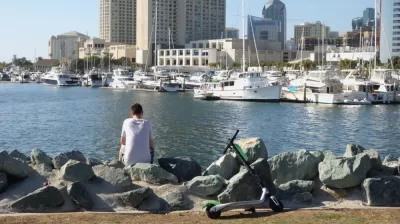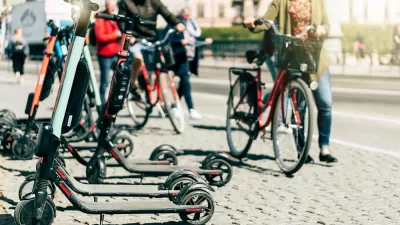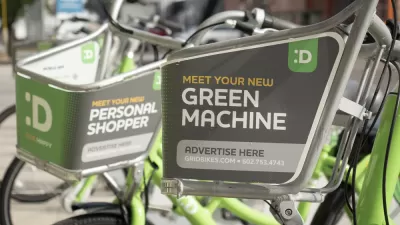With a little help and encouragement, active and micro modes, including walking, bicycling, scooters, e-bikes, and their variants, can provide huge benefits.

Active and motorized micro modes (walking, bicycling, e-scooters, e-bikes, and their variants) can provide huge benefits, if we take advantage of their potential.
According to the National Household Travel Survey approximately 12% of total personal trips in the United States are currently made by active modes, but with appropriate facility improvements and incentives, active and micro mode shares could be much higher and significantly reduce automobile travel.
According to the study, "Active Transportation Transforms America: The Case for Increased Public Investment in Walking and Biking Connectivity," approximately a quarter of all personal trips in the United States are one mile or less, suitable for a walk; half of all vehicle trips are three miles or less, suitable for a bike ride; and most trips are less than five miles, suitable for an e-bike ride. Similarly, a major academic study, "A Global High Shift Cycling Scenario," estimated that improving bicycle and e-bike conditions could increase urban bicycling mode shares from the current 6% up to 17% in 2030 and up to 22% in 2050. Other studies in North America and Europe estimate that, accounting for various climatic and geographic constraints, e-bikes could achieve 10-15% mode shares and produce up to 12% emission reductions in typical urban areas.
A major study for the New Zealand Transport Agency, "Mode Shift to Micromobility," estimated that 3-11% of all urban trips could be made by micromodes by 2030. This is predicted to increase use of active transportation facilities (paths and bike lanes) by three to eight times, and if well integrated with public transit, with good paths and bike lanes connecting to transit stops and stations, could increase transit ridership by up to 9%. Micromodes are particularly useful in suburban areas, where distances are too far for walking and bicycling, for travellers with heavy loads (such as transporting children or goods) or impairments, and for hilly terrain. One Dutch study found that e-bike purchasers increased bicycling from 2.1 to 9.2 average daily kilometers and reduced their car travel from 5.1 to 4.6 average daily kilometers, a 10% reduction in average daily mileage. That is huge!
Active and micromodes integrated with efficient public transit services can provide many large benefits, including more independent mobility for non-drivers (and therefore improved economic opportunity), consumer savings and affordability, road and parking congestion reductions, improved public fitness and health, reduced crash risk, reduced noise and air emission, and increased happiness. Such shifts could deliver an estimated $74-138 billion worth of annual benefits in the United States, taking into account user savings, public health, economic growth and opportunity, and environmental quality. Surveys indicate that many people want to use these modes more often, for enjoyment, health, and affordability.
However, with current policies we are unlikely to achieve these benefits. To take advantage of their potential, we need two major policy reforms.
First, we need more multimodal planning that is able to invest as much in active and micromodes as would be spent on roads and parking facilities to accommodate automobile travel. This creates what we often call a 15-minute neighborhood, which means that most commonly-accessed services and activities can be reached within a 15-minute walk or bike ride, so it is easy to live car-free. As previously mentioned, currently, about 12% of total trips are made by active modes, and with growth in micro modes, and improved facilities that share could double. This suggests that, for efficiency and fairness sake, a community could justify spending about a quarter of its transportation resources—money and road space—to accommodate active and micro modes, and even more if needed to achieve affordability, health and environmental goals. We aren't even close. Although it is difficult to obtain hard data, available sources indicate that most state departments of transportation spend less than 1% of their budgets. Local transportation agencies may spend a somewhat larger share, but still far smaller than what is spent on automobile travel, and a tiny portion of roadway and government mandated parking facility costs.
Second, we need Transportation Demand Management incentives that encourage people to use the most efficient mode for each trip, so even car owners will use active and micromodes for local errands and public transit when travelling along busy corridors. The problem we face is that, although automobiles are costly, representing 15-25% of most households' budget expenditures, most of those costs are fixed or external, unrelated to the amount a vehicle is driven. As a result, driving seems cheap, only about 15-cents per mile, which is generally less than public transit fares, and motorists feel like they should maximize their vehicle travel to get their money's worth from those large fixed investments. To achieve the potential benefits of active and micro modes, we need to increase fuel taxes or implement carbon taxes, apply efficient road and parking pricing, implement Pay-As-You-Drive vehicle pricing, prioritize curb access, and mandate or encourage employers to establish Commute Trip Reduction programs. In other words, public policies should reward travellers for the cost savings they provide—reduced road and parking facility costs, and reduced pollution emissions—when they shift from driving to more resource-efficient modes.
This is good news: modest modes can provide huge benefits, if we let them. The future belongs to the efficient!
For more information
AARP and CNU (2021), Enabling Better Places: A Handbook for Improved Neighborhoods, American Association of Retired Persons.
Torsha Bhattacharya, Kevin Mills, and Tiffany Mulally (2019), Active Transportation Transforms America: The Case for Increased Public Investment in Walking and Biking Connectivity, Rails-to-Trails Conservancy.
M. Ensor, O. Maxwell and O. Bruce (2021), Mode Shift to Micromobility, Research Report 674, NZ Transport Agency.
Knight Frank (2020), Walkability and Mixed Use - Making Valuable and Healthy Communities, The Prince’s Foundation.
Aslak Fyhri and Hanne Beate Sundfør (2020), “Do People Who Buy E-bikes Cycle More?” Transportation Research Part D, Vol. 86.
ITDP (2019), The Electric Assist: Leveraging E-Bikes and E-Scooters for More livable Cities, Institute for Transportation and Development Policies.
Jacob Mason, Lew Fulton and Zane McDonald (2015), A Global High Shift Cycling Scenario: The Potential for Dramatically Increasing Bicycle and E-bike Use in Cities Around the World, ITDP and the University of California.
Michael McQueen, John MacArthur and Christopher Cherry (2020), “The E-Bike Potential: Estimating Regional E-bike Impacts on Greenhouse Gas Emissions,” Transportation Research Part D, Vo. 87.
Polis (2019), Macro Managing Micro Mobility: Taking the Long View on Short Trips, POLIS.
Marc Schlossberg, et al. (2021), Rethinking Streets During COVID-19: An Evidence-Based Guide to 25 Quick Redesigns for Physical Distancing, Public Use, and Spatial Equity, University of Oregon’s Sustainable Cities Institute.
Adie Tomer, Joseph Kane and Jennifer S. Vey (2020), Connecting People and Places: Exploring New Measures of Travel Behavior, Brookings Institute.

Maui's Vacation Rental Debate Turns Ugly
Verbal attacks, misinformation campaigns and fistfights plague a high-stakes debate to convert thousands of vacation rentals into long-term housing.

Planetizen Federal Action Tracker
A weekly monitor of how Trump’s orders and actions are impacting planners and planning in America.

In Urban Planning, AI Prompting Could be the New Design Thinking
Creativity has long been key to great urban design. What if we see AI as our new creative partner?

King County Supportive Housing Program Offers Hope for Unhoused Residents
The county is taking a ‘Housing First’ approach that prioritizes getting people into housing, then offering wraparound supportive services.

Researchers Use AI to Get Clearer Picture of US Housing
Analysts are using artificial intelligence to supercharge their research by allowing them to comb through data faster. Though these AI tools can be error prone, they save time and housing researchers are optimistic about the future.

Making Shared Micromobility More Inclusive
Cities and shared mobility system operators can do more to include people with disabilities in planning and operations, per a new report.
Urban Design for Planners 1: Software Tools
This six-course series explores essential urban design concepts using open source software and equips planners with the tools they need to participate fully in the urban design process.
Planning for Universal Design
Learn the tools for implementing Universal Design in planning regulations.
planning NEXT
Appalachian Highlands Housing Partners
Mpact (founded as Rail~Volution)
City of Camden Redevelopment Agency
City of Astoria
City of Portland
City of Laramie






























